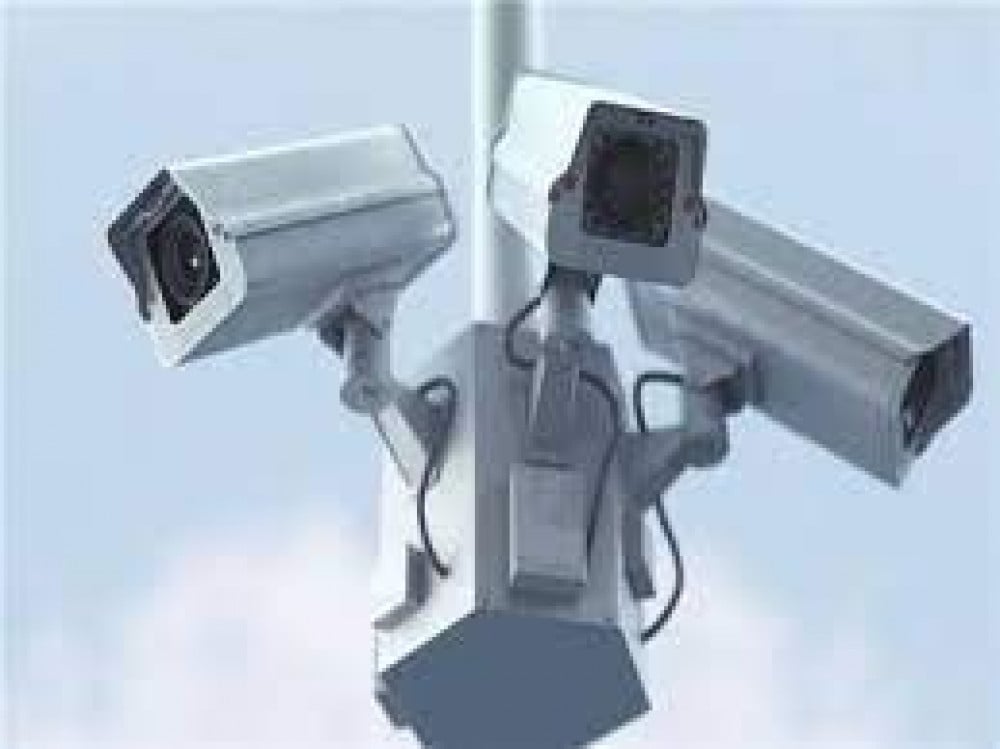
Article One:
The following words and phrases - wherever they appear in this system - shall have the meanings indicated in front of each of them, unless the context requires otherwise.
System: System for using security surveillance cameras.
Regulations: The executive regulations of the system.
Ministry: Ministry of Interior.
Minister: Minister of Interior.
The Committee: The Committee for Reviewing System Violations.
Security surveillance cameras: fixed or mobile devices, prepared to capture moving images in accordance with the provisions of the system, and does not include cameras placed by individuals inside private residential units and complexes.
Security surveillance camera systems: Systems connected to security surveillance camera systems devices for the purpose of monitoring, storing, and analyzing camera broadcasts.
Security surveillance camera system devices: cameras, servers, and storage media associated with security surveillance camera systems.
Storage media: containers used to store or transfer information and then retrieve it when needed, including: hard disk, mobile memory, magnetic disks, connections, and servers.
Recordings: Moving images captured by security surveillance cameras and saved on storage media.
Operations rooms: Monitoring and control rooms in the Ministry and the Presidency of State Security, linked to the National Information Center systems.
Terms document: A document of security conditions and requirements for installing a surveillance system and general technical specifications for security surveillance camera systems devices.
second subject:
The provisions of the system apply to the following:
1- Ministries, public bodies and institutions.
2- Oil and petrochemical facilities.
3- Power generation and water desalination facilities.
4- Tourist accommodation facilities.
5- Commercial complexes and shopping centers.
6- Financial institutions, banks, exchange centers and money transfer.
7- Residential buildings, including residential complexes and buildings, in accordance with the conditions document, what is specified by the regulations, and what is stipulated in the provisions contained in the system.
8- The Grand Mosque, the Prophet’s Mosque, and the holy sites.
9- Mosques and mosques.
10- Sports clubs, facilities and stadiums, public and private cultural facilities and youth centres.
11- Public and private entertainment facilities.
12- Public and private health facilities, including: medical cities, hospitals and clinics.
13- Commercial warehouses.
14- Main roads and their intersections within cities.
15- Highways linking cities and governorates.
16- Fueling stations and gas selling places.
17- Public and private educational facilities.
18- Establishments that provide food services.
19- Public transportation.
20- Places for holding events and festivals.
21- Places of economic and commercial activities. 22- Public and private museums and historical and heritage sites prepared to receive visitors.
23- Any site, activity or facility that the Ministry deems appropriate to add.
The regulations specify the locations of security surveillance cameras and the controls for maintaining their systems devices, taking into account the privacy of individuals and what is stipulated in the provisions of the system.
Article Three:
The competent government authority may not license those subject to the provisions of the system to practice an activity or renew a license to practice that activity. Only after meeting the requirements for installing security surveillance camera systems devices specified in the conditions document.
Article Four:
1- Those subject to the provisions of the law must install and maintain security surveillance camera systems and operate them around the clock.
2- Those subject to the provisions of the system must keep the recordings according to the period stipulated in the conditions document, and the recording must remain preserved and not be modified in the event that there is a report about a specific incident until the end of the investigation procedures, and it must be delivered to the Ministry or the Presidency of State Security - according to Circumstances - upon request.
3- The Ministry classifies those subject to the provisions of the system according to the following:
A- Highly sensitive entities, facilities or properties. It must connect its security surveillance camera systems directly to the operating rooms via secure networks in accordance with the terms and conditions document. According to security need.
B- Medium-sensitive entities, facilities, or properties. It must connect its security surveillance camera systems directly to the operating rooms via open communication networks in accordance with the terms and conditions document. According to security need.
C- Low-sensitivity entities, facilities or property that do not require connection to operating rooms.
4- Security and military government agencies, the Ministry of Foreign Affairs, and residential buildings, including residential complexes and buildings, are excluded from connection to the operating rooms referred to in Paragraph (3) of this article.
Article Five:
It is not permissible to engage in the activity of manufacturing or importing security surveillance cameras - stipulated in the system - or selling, installing, operating or maintaining them, except after obtaining the necessary approvals from the Ministry, in accordance with the procedures specified by the regulation.
Article Six:
1- It is prohibited to install security surveillance cameras inside the following places for the categories covered by the provisions of the system:
A- Rooms: (medical examination, hypnosis, physical therapy, and changing clothes), bathrooms, salons and women’s clubs, and the residential unit in the tourist accommodation facility.
B- Medical operating rooms and private places. The regulations specify the categories covered by this paragraph.
C- What the regulations specify in other places in accordance with the provisions of the system.
2- A visible sign or boards must be placed in the places covered by the provisions of the system, indicating that they are equipped with security surveillance cameras. The regulations specify their specifications, number, and locations.
3- It is prohibited to transfer or publish recordings except with the approval of the Ministry or the Presidency of State Security - as the case may be - or based on a judicial order, or at the request of the competent investigation authority.
Article Seven:
The Ministry or the Presidency of State Security - as the case may be - may view the broadcasts and recordings of security surveillance cameras, keep a copy of them, and process and analyze their data if there is a necessity and for reasons related to security, in a manner that does not conflict with the relevant regulations, and submit them to the competent court or the competent investigation authority, if requested. that.
Article Eight:
The Saudi Data and Artificial Intelligence Authority - using data and artificial intelligence technologies - is responsible for developing systems for processing and analyzing broadcasts and recordings of security surveillance cameras, and enabling the Ministry and the Presidency of State Security - as the case may be - to use and benefit from them in accordance with the relevant regulations. This does not conflict with the relevant regulations.
Article Nine:
1- Violations of the provisions of the system are controlled and recorded in reports in accordance with the procedures specified by the regulations.
2- Employees - appointed by a decision from the Minister - are responsible for controlling violations of the provisions of the system. The regulations specify their work procedures in accordance with the provisions of the system.
Article 10:
The Ministry may assign the tasks of controlling some violations of the provisions of the system - other than violations of a security nature - to the private sector. This is in accordance with the relevant regulatory procedures.
Article Eleven:
By decision of the Minister, a committee (or more) shall be formed in each region, consisting of three members, one of whom shall hold a legal or legal qualification. To consider the violations stipulated in the system and determine the appropriate penalty, in accordance with what is stated in Article (Twelve) of the system.
Article Twelve:
1- Without prejudice to any more severe penalty stipulated by another law, every person with a special natural or legal capacity - subject to the provisions of the law - who violates any provision of the law shall be punished in accordance with the following:
A- A fine of (five hundred) riyals for each security surveillance camera, and for each security camera surveillance system device, that violates the technical specifications stated in the conditions document.
B- A fine of (one thousand) riyals for each security surveillance camera, and for each security camera surveillance system device that was not installed in accordance with what was specified in the conditions document.
C- A fine of (one thousand) riyals for each violation of the provisions of Paragraph (2) of Article (Six) of the system.
D- A fine of (five thousand) riyals for a violation of not keeping records in accordance with what was stated in Paragraph (2) of Article (Fourth) of the system.
E- A fine of (ten thousand) riyals for each violation of the provisions of Paragraph (1) of Article (Six) of the system.
F- A fine of (twenty thousand) riyals shall be imposed on anyone who transmits or publishes recordings in violation of the provisions of the system, or damages or sabotages security surveillance camera system devices or recordings.
2- The Minister shall issue a decision specifying the violations in which the violator is obligated - within a specific period - to remove the site of the violation, taking into account that if the specified period expires without doing what he is obligated to do, a new violation will be charged against him.
Article Thirteen:
Anyone against whom a penalty decision has been issued may file a grievance against it before the Administrative Court within (sixty) days from the date of notification of the decision.
Article Fourteen:
Those subject to the provisions of the system must adhere to the following:
1- The conditions, security requirements and technical specifications contained in the conditions document. Entities subject to the supervision of the Higher Authority for Industrial Security - in addition to the provisions contained in the system and the terms and conditions document - adhere to the security specifications issued by the Authority.
2- Managing and using the systems associated with surveillance camera systems devices, by implementing what is issued by the National Cybersecurity Authority and what is stipulated in the terms and conditions document.
Article fifteen:
The Minister - or his authorized representative - may grant - in accordance with controls and conditions set by the Minister - whoever helps in uncovering any violation of the provisions of the system an incentive financial reward not exceeding (10%) of the amount of the fine collected from the violation. Provided that he is not a Ministry employee or someone used to control violations or perform oversight or inspection tasks.
Article sixteen:
The Ministry - in conjunction with the Ministry of Communications and Information Technology, the Presidency of State Security, the National Cybersecurity Authority, the Saudi Data and Artificial Intelligence Authority, the Saudi Standards, Metrology and Quality Authority, and other relevant bodies - shall prepare the conditions document and propose any amendments that may be required, as necessary. .
The document shall be issued by a decision of the Minister within (one hundred and eighty) days from the date of publication of the system in the Official Gazette, and shall be effective from the date of entry into force of the system.
Article Seventeen:
The Minister shall issue the regulation within (one hundred and eighty) days from the date of publication of the regulation in the Official Gazette, and it shall be effective from the date of its implementation.
Article Eighteen:
The system will come into effect after (one hundred and eighty) days from the date of its publication in the Official Gazette.

